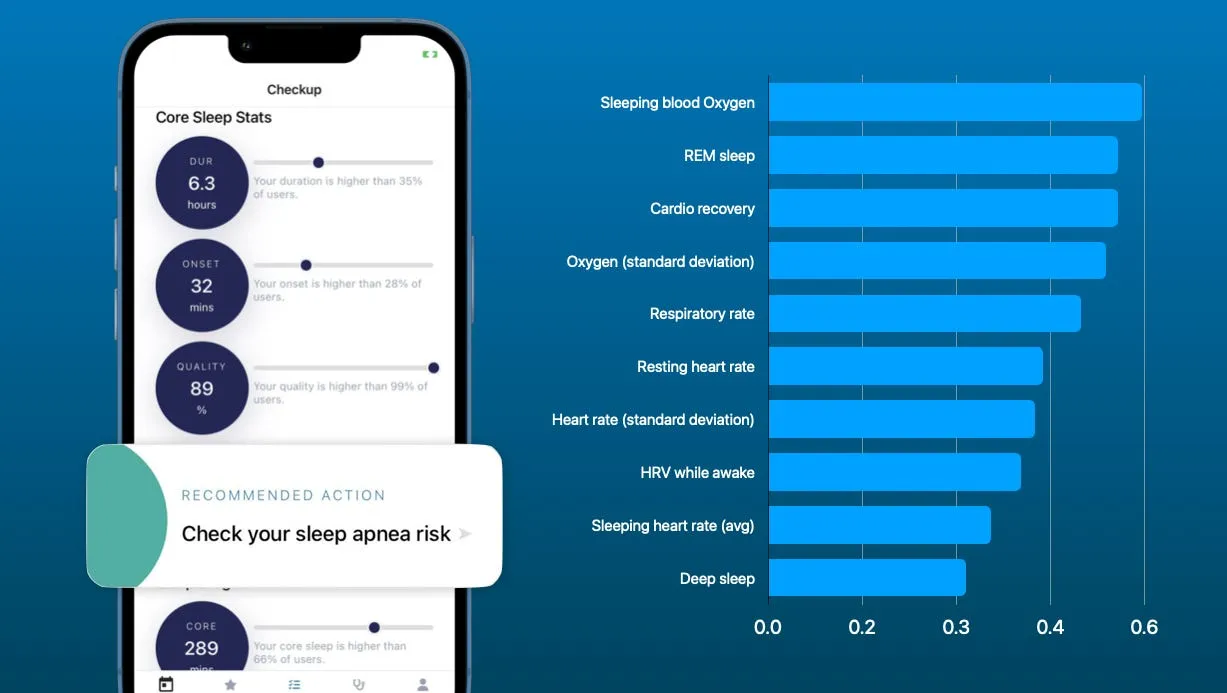The classic sign of sleep apnea is low blood oxygen during sleep. But I recently did a data analysis and was surprised that, out of the top 10 signals correlated with high sleep apnea risk, 5 are cardiovascular.

This analysis is based on the sleep apnea risk assessment feature of Empirical Sleep. If you want to check your risk — and talk directly with a doctor about follow-up testing — then download Empirical Sleep for Apple Watch on the App Store.
The cardiovascular signals most correlated with sleep apnea
Cardio recovery & sleep apnea
Cardio recovery—also called called heart rate recovery—measures how how fast your heart rate returns to normal after exercise. It’s a good measure of your heart’s health and how well your autonomic nervous system (the system that controls involuntary actions like heart rate and digestion) is working. People with sleep apnea often have problems with this system because their breathing stops and starts throughout the night, which stresses their heart.
Resting heart rate & sleeping heart rate
Your resting heart rate (RHR) is the number of times your heart beats per minute when you’re at rest. It gives a snapshot of your overall heart health. For those with sleep apnea, the constant interruptions in breathing can activate the fight-or-flight response (part of the autonomic nervous system), which keeps the heart working harder even at rest. This leads to a higher RHR.
So, if someone’s resting heart rate is consistently high, it could be a red flag for sleep apnea. The same is true of your average heart rate while asleep.
HRV (heart rate variability)
Heart rate variability (HRV) measures the variations in time between each heartbeat. It reflects how well the autonomic nervous system is balancing the sympathetic (fight-or-flight) and parasympathetic (rest-and-digest) responses. High HRV means your body can adapt well to different situations, but sleep apnea can mess this up. Frequent breathing interruptions at night can lower HRV because they increase stress and reduce the body’s ability to relax.
How this analysis correlated Apple Watch sensors with a medical survey instrument
This analysis is based on 1,270 risk assessments for sleep apnea that have been completed through Empirical Sleep. Our risk assessment is based on the STOP-BANG survey. The data was first de-identified to preserve privacy. Then, all Apple Watch metrics — oxygen, cardio recovery, temperature, etc — were normaalized to have a mean of 0 and standard deviation of 1.0. Then, those with high risk and low risk were separated into two groups, with the average of their normalized Apple Watch metrics (oxygen, cardio recovery, temperature, etc) taken for each group and ranked based on difference. In the chart above, a strength of 0.5 means those with high risk are 0.5 standard deviations above (or below) those with low risk.
Talk with a doctor about sleep apnea through Empirical Sleep
You can check your risk of sleep apnea through Empirical Sleep for Apple Watch. And if you’re at medium or high risk, you can talk with a doctor directly in the app to figure out next steps, including FDA-cleared sleep apnea tests covered by insurance.
Get your free 30-day heart health guide
Evidence-based steps to optimize your heart health.
